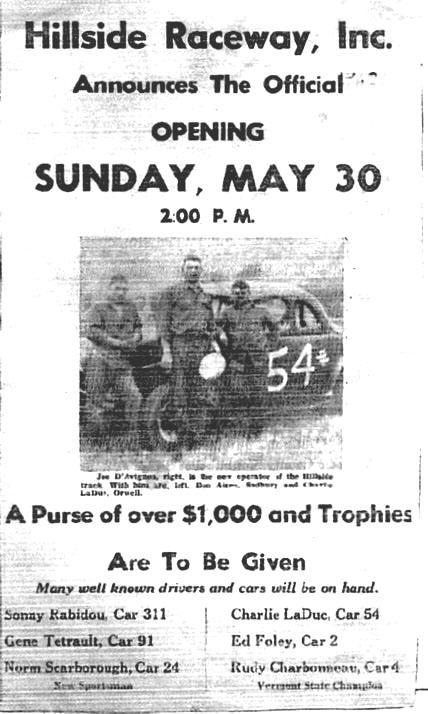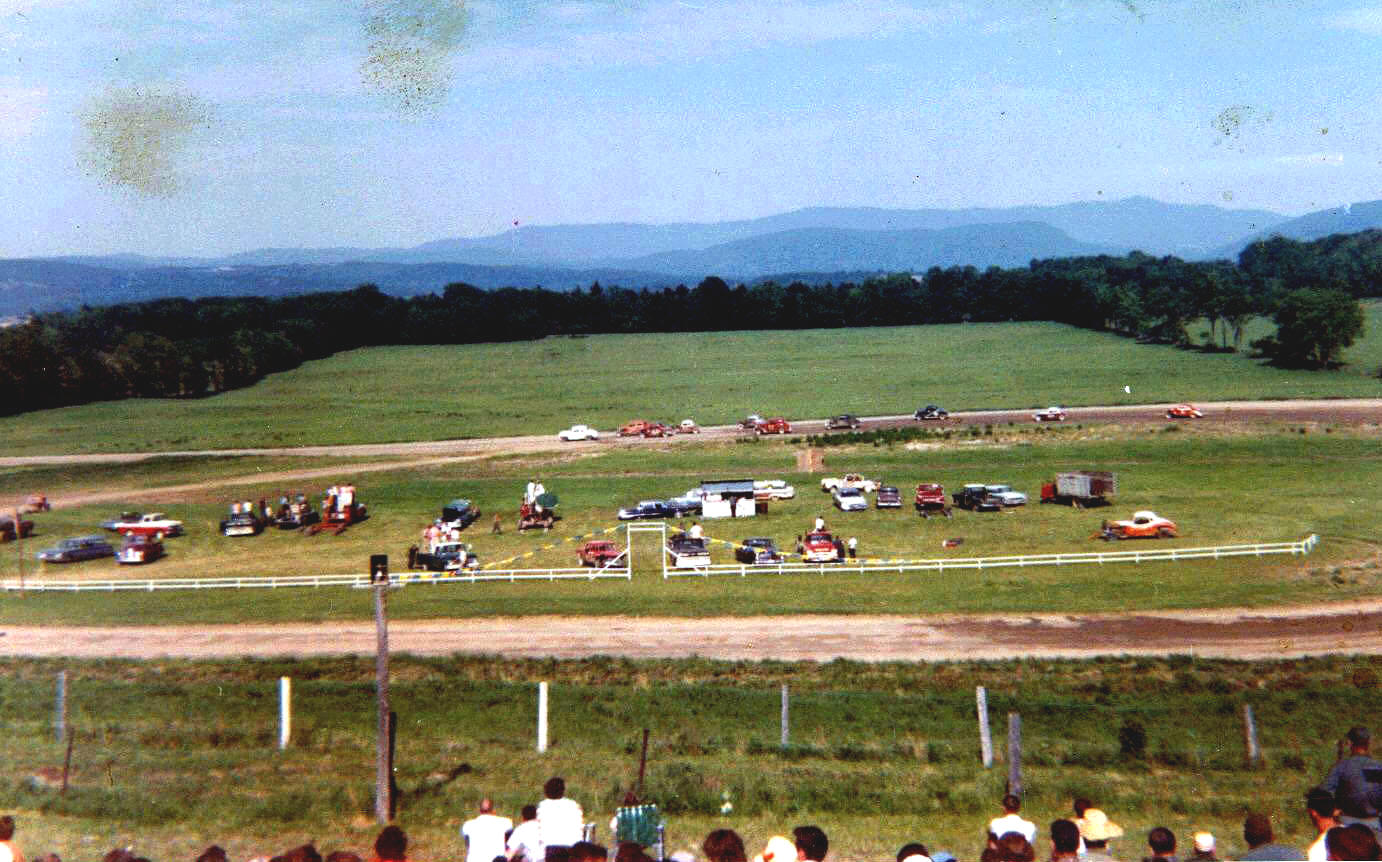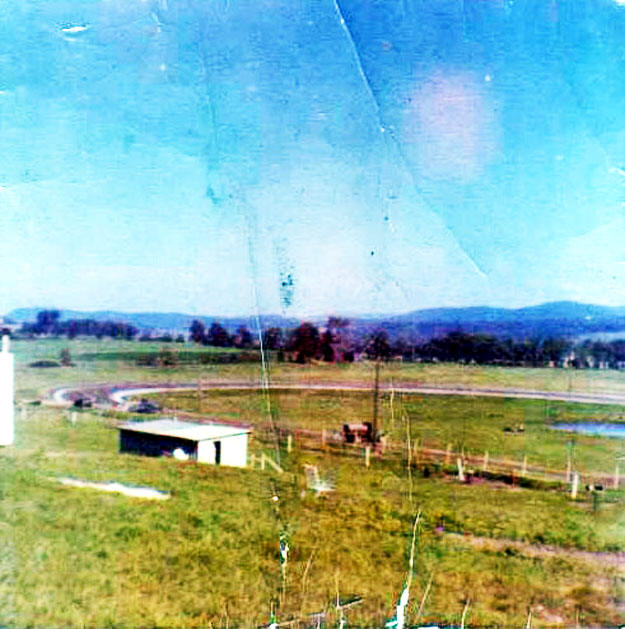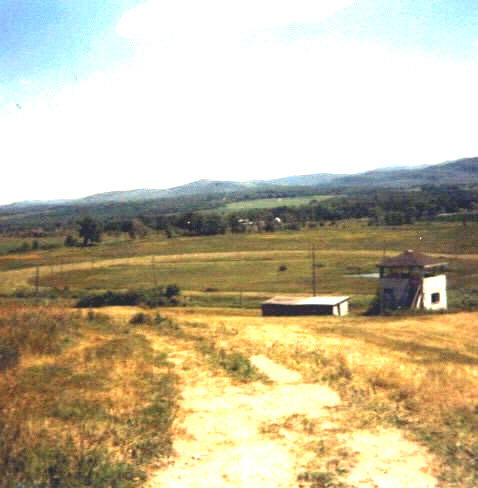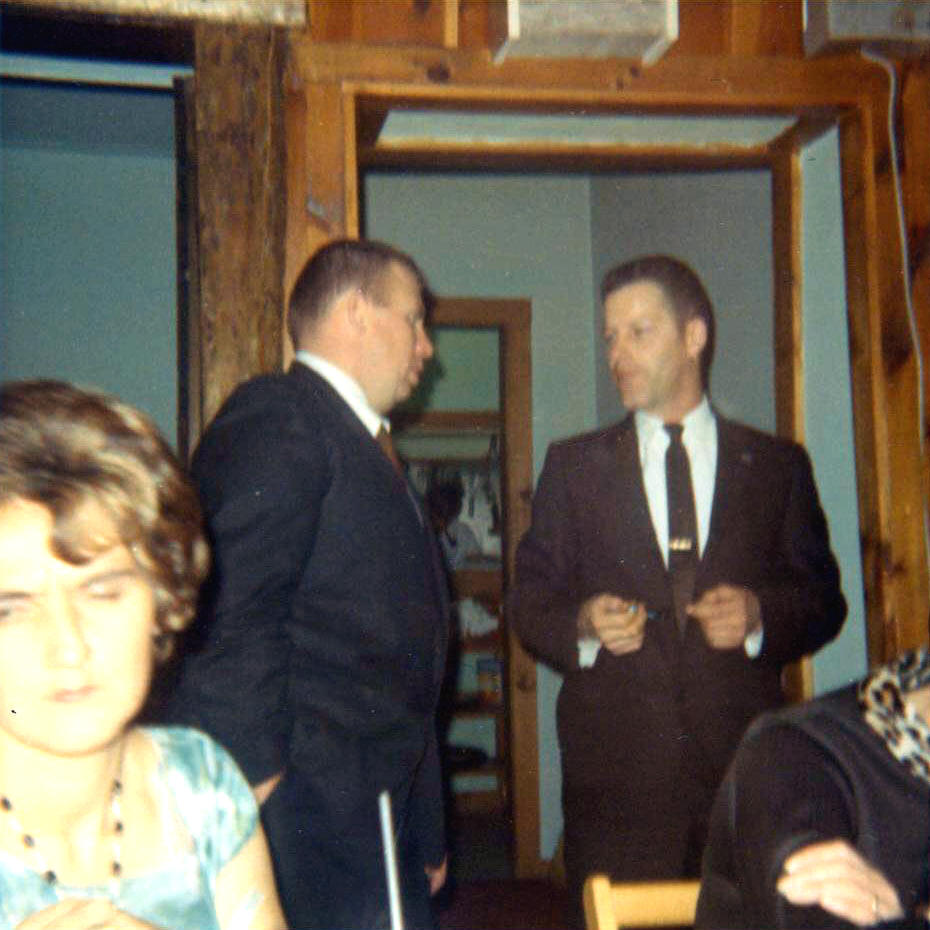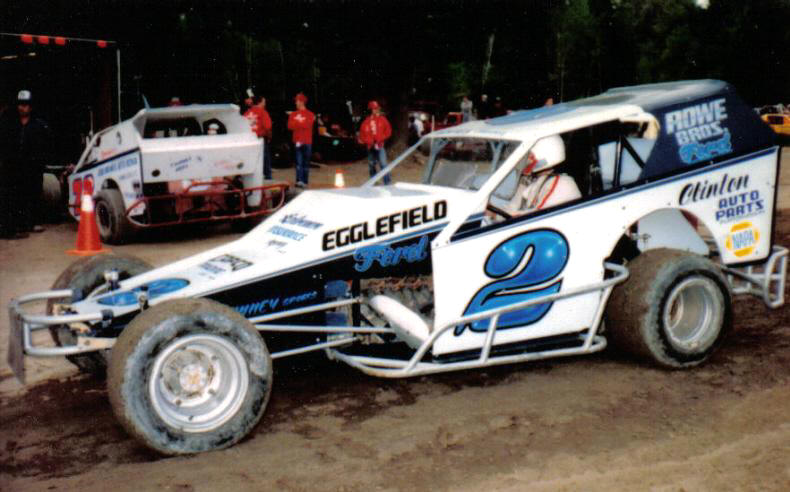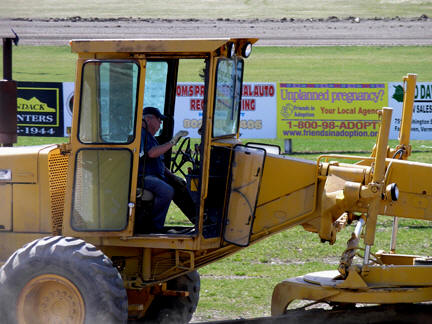On April 9 I received one of those small, unexpected little email surprises that make all of this historic work worthwhile. Via Diana Peters, I got two rare, family – camera photos from around 1969, when the race track in Waltham, Vermont – near Vergennes – was about to enter the last phase of its struggling lifetime. Actually, that particular location, on the Hi Monroe farm off South Middlebrook Road, is the venue for the great majority of this subject.

Courtesy of Cho Lee
A heat from the very
first month of Otter Creek Speedway in 1961. Jim Hampton’s Hudson leads
a rapidly – closing Beaver Dragon. Car 1, which was Jack DuBrul, was the
fastest car in that field.
C. J. Richards was inspired by his brief racing experiences at such tracks as Ashland Park, in Warrensburg, NY and at Colchester – Bayview Speedway in Malletts Bay, VT; and also by the experience of he and his father attending races at Fairmont Park Motor Speedway, Hugh Young’s brief promotion at the old fairgrounds in Fair Haven. As a result, he embarked upon his own racing promotion, by 1962, at that same Fair Haven track. He always said he knew that Fairmont location would never suffice as a permanent location [too close to town].
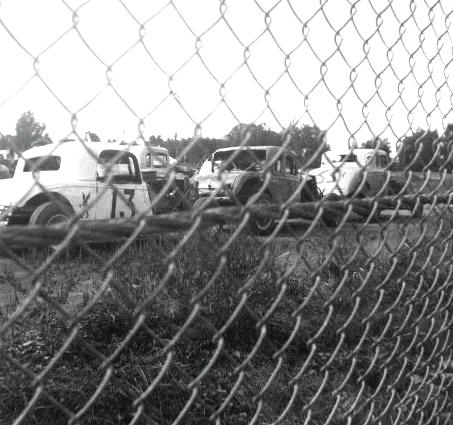
Ladabouche Photo
This high – handicap
heat at Fairmont Speedway, 1962 shows the predominance of the
flathead coupes at that time. #13 is Buddy Bardwell, a Keene, NH driver.
Richards’ Fairmont Speedway [under the Champlain Valley Racing Association] turned out to be well located and well – timed. His promotion of a dirt half – mile had been preceded by the aforementioned Waltham track, in 1961. Landowner Hi Monroe, a former farmer – turned construction contractor had partnered up with cattle dealer Lee Tucker to produce a track in Monroe’s lower pasture that was actually longer than a half mile. The two had been wise enough to get a NASCAR sanction, perhaps in reaction to the massive success of the unsanctioned Thunder Road or, just maybe, because NASCAR had not had a foothold in Vermont since Colchester – Bayview had closed its gates after the 1959 season.
The Otter Creek Speedway soldiered along with Monroe and Tucker for two seasons, becoming the most critically – important venue for national points – seeking NASCAR sportsman teams in the region that nobody knew about. The track was always ornery, being bumpy, dusty, and wet all at the same time. It was very hard on equipment and the bleachers’ far distance from the track did not do much to increase spectator enthusiasm. It stood to reason that many of the Otter Creek hobby division competitors were excited when Fairmont Speedway opened in 1962; so, naturally, Richards would become embroiled in the fortunes of the Addison County rural track as much by default as anything else.
Bob Mackey Photo Courtesy of John Rock
A typical field at
the early Otter Creek track. Ed Foley and Jack Cutter, in hobby cars, run for
their
lives as the thundering V-8 sportsman cars like Bob Bruno and Ken Shoemaker
catch up quickly.
Richards once told me that it was in his interest to have the Otter Creek track remain active, as the existence of two tracks encouraged not only more local guys to stay involved, but it also attracted a number of teams from outside the immediate area. When Otter Creek floundered after its 1962 season, that season compromised by the attraction of fans to the more exciting Fairmont track, it became immediately obvious to C.J. that someone had better keep the track going. Some of his best - developing local talent was coming out of the Whiting, Vermont area, right in the shadow of the Monroe track: Vince Quenneville, Eddie Foley, Phil Russell, and Little Joe D’Avignon were some of the Fairmont local boys who had started out at Otter Creek.
So, by 1963, Otter Creek was being run by CVRA and Richards. Richards had also down some aggressive promotion at the Vermont State Fair, at Rutland, and had put on a few huge shows, the first of which [in 1962] had set the stage for several of the Otter Creek regulars who did not ordinarily run Fairmont to race head – to – head against the Fair Haven regulars. Bob Bushey, in Sullivan’s 586 Hudson and Bob Russell and his fast #115 were two such cases. These two groups did not mix all that well, as was evidenced by Phil Russell’s black and yellow “Checkmate” Hudson dumping Glens Falls driver Art Rivers and his #About 5” over a fence and into the infield in front of the grandstands. A highly – annoyed CVRA staff proceeded to dump Russell for the afternoon.
Courtesy of Wes Moody
OOPS !
Apparently running two tracks was not working well for Richards, and the Waltham track was not operated in 1964. Richards was looking at what he wanted to do with his lead division, and he was still trying fairgrounds shows; so, struggling along with the difficult Monroe location was not in the cards that year. As a matter of fact, C. J. did not want the majority of the fans to know that he was dividing his attentions from their beloved Fairmont track after that 1963 season.
1965 was a pivotal year for the CVRA. Richards had decided to make the overhead V-8 sportsman the featured car in his lead division. This was going to place him in direct competition with not only the Fonda Speedways and the Lebanon Valleys; but he was keeping a nervous eye upon NASCAR and its new project to the North – Catamount Stadium. With Catamount and Thunder Road also running sportsman cars, that void in the middle of the state, namely Addison County, was troubling to Richards. He knew Ken Squier and his partners were thinking the same thing, but he also knew that had enough on their plate trying to get a big – dollar new race track off the ground.
Source Unknown
D’Avignon showed mostly his Addison County neighbors in his first advertising flier early in 1965. Below – The
field circles patiently under yellow as a small wreck [off screen to the right] was slowly cleaned up. Not a bad field - it includes Ed Foley, Vince Quenneville, Charlie Laduc, Gene Tetrault, Don Miller, Sonny Rabideau, and Ted Brown.
Ladabouche Collection, Courtesy of Val Blicarz
This is when the puppeteer’s strings came out. According to what the public knew, CVRA regular Joseph “Little Joe” D’Avignon, a garage operator from Cornwall, VT with a huge family, had decided to re – open the old Otter Creek Speedway, re – naming is as Hillside Raceway. D’Avignon would run the track, with all of his many kids manning the jobs like concession stands and the various “gofer” jobs. D’Avignon would even recruit the services of Middlebury College professor, Dr. Frank Lane, his neighbor, to head the scoring crew. Hillside’s creation would inspire a few of the Addison County guys running at Fairmont to cast aside hobby cars and obtain a sportsman.
Hillside would enjoy the excitement generated by the overhead V-8 sportsman car virtually taking over the entire state’s racing. Both Thunder Road and Fairmont did see some leftover flathead competition mixed in with the overheads; but, the Thunder Road teams knew they would only be allowed to run the flatheads in 1965, and the Fairmont teams could see that their competitive dies had been cast. Hillside programs were run on a Sunday afternoon at the un – illuminated track after Fairmont had run the night before. C.J. always claimed he was largely running Hillside, with D’Avignon as a figurehead of sorts.
Courtesy of the LaFond Family
Little Joe D’Avignon, seen walking from his car in one of the big pile – ups at C.J. Richard’s first fairgrounds race in 1962. Does anyone have any idea who A11 is ? or #30? They are almost the only cars from that day I can't ID.
Richards would do everything possible to entice or prod teams into going to Hillside Raceway, sometimes having to offer financial help for broken down cars to be fixed overnight. The Hillside fields were never close to what Fairmont was enjoying, but they had some quality in those modest lineups: Vince Quenneville, from nearby Whiting could be seen in the brand new Gael Dundon #3 ’37 Chevy sportsman coupe: Harry “Boo” Duffany, Jr, in Quenneville’s old Dundon ride; Dutch Reed, driving the Clayton Ryan “Shelby’s Cobra” #11 Ford; Roger Gauthier, in Al Ryan’s #28; Gene Tetrault in the #91 sedan; Charlie LaDuc, in his sportsman which had previously run the track as Dick Hawkins’ hobby entry; and track veteran, Eddie Foley.
D’Avignon would stay with the project for the better part of the 1965 season, although he was not making out well, despite some pretty impressive new entries showing up on a reasonably regular basis. Hillside saw the debut of Graham’s Trudo’s infamous ’50 Ford “hobby” car that looked like a modified. The track also had some of the first appearances of Dexter Dorr’s first sportsman cars, the SUPER 29 that eventually ended up as Vince Quenneville’s Devil’s Bowl car in 1967. Connecticut’s Jim Koehler, who as a NASCAR sportsman competitor had run the track in the NASCAR days, was back with a new 11CT. Sometimes, D’Avignon had to mix the late model hobbies in with the sportsman cars to make a field. After a year, he was done.
Ladabouche Photo
Vince Quenneville [against car] and car owner Gael Dundon [kneeling] supported Hillside Speedway from
nearby Whiting, VT. I have recently learned that the car was purchased from Connecticut by Dundon.
The Monroe property was to lie dormant, as far as race tracks were concerned, until 1969. Richards, who had become occupied with the moving of his operation to his newly – constructed devil’s Bowl Speedway in West Haven, simply was not willing to invest in the Waltham property any more. Sumacs would begin to creep into the spaces where the stands and the announcer’s tower stood. The racing surface would be ravaged by the weather for all those years. It probably would have stayed that way forever had Richards not made the controversial decision to pave his Devil’s Bowl in 1970.
Obviously, there must have been conversation to that effect after the 1969 Bowl season and at the banquet that December. Something inspired one of Richards’ late model drivers to try and keep dirt racing in mid – Vermont alive. Maybe part of that something was C.J. Richards. The Waltham track location had never been far from the minds of local Addison County racing folk; but, curiously, Senecal was from Rutland County. Plans were put into place to stage races there in 1970, under the moniker of Rainbow Ridge Raceway.
Courtesy of Darrell Tucker Ladabouche Photo
The Rainbow Ridge sign gives evidence that it was a small operation. Below - What the track looked like during
mid – week work. Furthest below – Almost the exact same view when the track was dormant for good, by 1977.
Courtesy of Diana Peters
Ladabouche Photo
This shot shows the tower, and the 1970 shot does not. It was there – it is just the angle at
which the 1970 was taken. Someone had just cut the hay right around the track.
Speaking in 2012 about his experiences running a track, Senecal hinted that Richards had a distant hand in the track, offering considerable advice and helping to make helpful contacts, as he could, to afford Senecal things like a track water truck. Both men figured that the recalcitrant locals who refused to run on the pavement at the Bowl might stay in the sport by running at the rustic Waltham track. This would keep some aces up Richards’ sleeve until things sorted out. Unfortunately, Louie, brother – in – law Bill Herrick, and partial partner Roland Prouty were finding out just how hard it was to run a track – especially a dirt track.
After a tiring stretch of reclaiming the property, in several places, by weeks of work with a brush hog, they had to set to work bracing up the rotting announcer’s stand, as well as replacing bleachers, building a concession stand, adding warning lights, and installing a safe starter’s stand. [The track had never had either the lights or the flag stand]. They had managed to guarantee $3,000 for a big Memorial Day show, with a healthy winner’s share; it then rained the entire weekend. Senecal had retained a man named Frenchy to run the concession stand. When the track closed, Frenchy beat it with the proceeds and never paid the track a cent.
